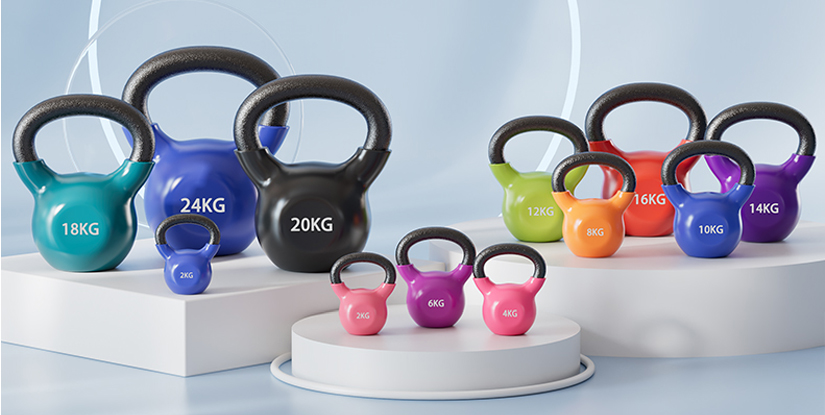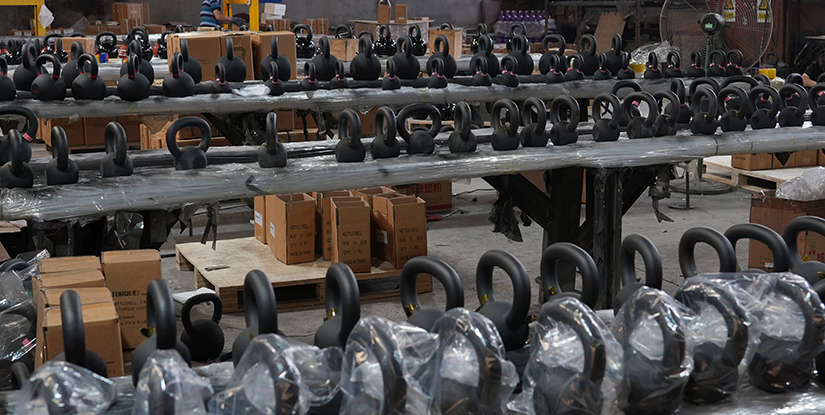When I first started paying attention to kettlebell colors and weights, I honestly thought it was just a design thing—like, “Oh cool, this pink one looks fun.” Yeah… turns out, not even close.
At the gym, I kept grabbing random bells just by the color, thinking they were all about the same. Spoiler: they weren’t. One minute I was swinging a blue bell no problem—next thing I know, I grabbed a yellow one and almost threw out my back.
Eventually, someone clued me in—those colors actually mean something. Let’s break it down nice and simple.
Standard Kettlebell Color and Weight Chart
Once I realized the colors weren’t just random paint jobs, I went looking for a clear chart. Turns out, there’s a pretty standard system — especially in competition-style kettlebells, which a lot of commercial gyms use.
Now, not every gym sticks to this. Some brands go rogue with their own colors (super annoying). But if you’re working with comp-style bells, this is usually what you’ll see:
| KG | LB | Color |
|---|---|---|
| 8 kg | 17.6 lbs | Pink |
| 12 kg | 26.4 lbs | Blue |
| 16 kg | 35.2 lbs | Yellow |
| 20 kg | 44.0 lbs | Purple |
| 24 kg | 52.8 lbs | Green |
| 28 kg | 61.6 lbs | Orange |
| 32 kg | 70.4 lbs | Red |
| 36 kg | 79.2 lbs | Grey |
| 40 kg | 88.0 lbs | White |
| 44 kg | 96.8 lbs | Silver |
| 48 kg | 105.6 lbs | Gold |
Yep, it’s a rainbow — but it’s got rules.
Now, this is the official layout for competition bells. If you’re running group classes or working with multiple trainers, getting everyone familiar with this system can really clean things up. No more “what weight is this again?” mid-set.
Also — don’t stress if your gym’s bells don’t match this chart exactly. Just know this version is the baseline a lot of gyms and coaches use.

Why the Color Coding Even Matters
At first, I thought the kettlebell colors were just for looks — maybe some kind of brand flair.
But nope. There’s a real reason behind it, and once I got it, things clicked fast — especially in a fast-paced gym setting.
Here’s why it actually matters:
- You can spot weights instantly. No squinting mid-class or guessing if it’s a 16kg or a 20kg. Yellow? Boom — 16kg. Easy.
- Transitions get way smoother. Especially in circuits or bootcamp-style setups where you’ve got people moving station to station.
- It keeps things organized. When everyone on the floor knows the color system, it cuts down on the chaos. Coaches don’t need to repeat themselves. Members feel more confident grabbing the right bell.
- It’s built for speed and consistency. In a commercial gym, where you’re juggling different levels of experience, color coding just makes life easier for everyone.
So yeah — those bright colors aren’t just for style. They’re actually doing some serious work behind the scenes.
Ever Wondered About Competition Kettlebell Colors?
Here’s a fun twist I didn’t know at first — the whole kettlebell color code thing actually started with competition kettlebells.
Basically, these are the bells used in sport-style lifting. And here’s the kicker:
They’re all the same size, no matter how heavy they are.
Yep — a 12kg bell and a 32kg bell? Same height, same shape. Totally different colors though.
That’s where the color coding really started. It helps athletes (and now coaches like us) quickly tell what’s what without having to check the side of every bell.
In a commercial gym, this system works beautifully — especially if your members are mixing weights across stations or following a coach’s cue on the fly.
👉 Curious how that all works? Check this out:
What Competition Kettlebell Colors Actually Mean
Trust me — it makes way more sense once you see the full breakdown.
Not All Kettlebells Are Created Equal
So here’s where I totally goofed…
Back when I was trying to match kettlebell colors and weights, I grabbed a cast iron bell thinking it’d line up with the chart I had. Spoiler: it didn’t. Not even close.
Turns out, cast iron and steel kettlebells are two totally different beasts.
Steel bells (the competition-style ones) follow that color coding we talked about. Cast iron ones? They don’t. Some are black, some are random colors, and a lot of them are shaped different too.
In a commercial gym setting, that stuff matters. You want consistency, especially when members are jumping in and out of workouts. Mixing bell types just adds confusion.
👉 If you’re stuck choosing between the two, here’s what happened when I learned the hard way:
Cast Iron vs Steel Kettlebells: What I Learned the Hard Way
Save yourself the headache.
Colors Are One Thing—But What About Weight Progression?
Alright, so knowing the kettlebell colors and weights is great and all… but it doesn’t answer the big question I kept running into:
When do you actually level up?
I used to think it was simple—just grab the next color up and roll with it. Yeah… not quite.
In reality, kettlebell weight progression isn’t always a straight line.
👉 Here’s what finally helped me figure it out without blowing up my shoulders:
Kettlebell Weight Progression: How I Figured Out When to Level Up
Trust me, it’s worth dialing this in. Especially when you’re coaching others.
Not gonna lie, I used to think kettlebell colors were just a design thing. But now I see why they matter—especially in busy gyms. Coaches and members can move quicker, stay organized, and know what’s coming. Purple? Light. Yellow? Brace yourself.
FAQs about Kettlebell Colors and Weights
Kettlebells come in a wide range of weights, which are typically organized into specific categories to suit various levels of strength and fitness goals. The weight categories vary depending on the kettlebell’s intended use, whether for beginners, intermediate lifters, or advanced athletes. Common weight categories for kettlebells are as follows:
Lightweights (Beginner to Intermediate): 4 kg (8.8 lbs) to 12 kg (26.4 lbs). These weights are ideal for beginners or for those focusing on endurance and technique.
Medium Weights (Intermediate to Advanced): 14 kg (30.9 lbs) to 20 kg (44 lbs). These are often used for more advanced exercises and for building strength.
Heavy Weights (Advanced): 24 kg (52.8 lbs) and above, with the heaviest kettlebells reaching up to 48 kg (105.6 lbs). These are suitable for experienced kettlebell practitioners focused on maximum strength training.
The color coding system allows for easy identification of these categories, with different colors representing specific weight increments. For example, a blue kettlebell typically weighs 12 kg (26.4 lbs), while a green kettlebell represents 24 kg (52.8 lbs). Understanding these weight categories helps users choose the right kettlebell based on their current fitness level and training goals.
In the standardized kettlebell color-coding system, the green kettlebell typically represents 24 kg (52.8 lbs). This weight is considered ideal for intermediate to advanced kettlebell users who have developed a solid foundation in strength training and are looking to challenge themselves with heavier lifts. A 24 kg green kettlebell is commonly used for exercises like kettlebell swings, cleans, snatches, and presses, as it provides a good balance between weight and explosiveness for building both strength and endurance. For beginners, the green kettlebell may be too heavy, and they may benefit from starting with lighter weights, such as the pink (8 kg) or blue (12 kg) kettlebells. However, for more seasoned kettlebell practitioners, the green kettlebell is an essential part of their training routine, helping to increase strength, power, and core stability.
A purple kettlebell typically weighs 20 kg (44 lbs) in the standard kettlebell color-coding system. This weight is often ideal for intermediate kettlebell users who have already built a basic level of strength and endurance. At 20 kg, the purple kettlebell offers a good challenge for exercises aimed at improving overall power, conditioning, and strength. For example, it is commonly used for kettlebell swings, squats, snatches, and other compound exercises that target multiple muscle groups. While it may be too heavy for complete beginners, it is a popular choice for individuals who have been training with lighter kettlebells (such as the pink or blue kettlebells) and are ready to progress to a more challenging weight. The purple kettlebell helps athletes increase their strength and endurance, with many lifting it in combination with other kettlebell weights for a more varied and dynamic workout routine.

Hi, I’m the editor here at Leadman Fitness. We’re a manufacturer focused on producing top-quality barbells, plates, kettlebells, dumbbells, and strength training gear. I’ve been into sports and fitness for years, and I know my way around all kinds of gym equipment—both from using it and helping create it.
I spend a lot of time understanding the real problems people run into in the gym—whether it’s beginners trying to pick the right gear or experienced lifters looking for something more durable. I stay in close touch with our production team and talk directly with other equipment makers, so we’re always improving based on what real lifters and coaches are looking for.
What I share comes from hands-on experience—stuff that actually helps people train better, not just in theory, but in real gyms.
